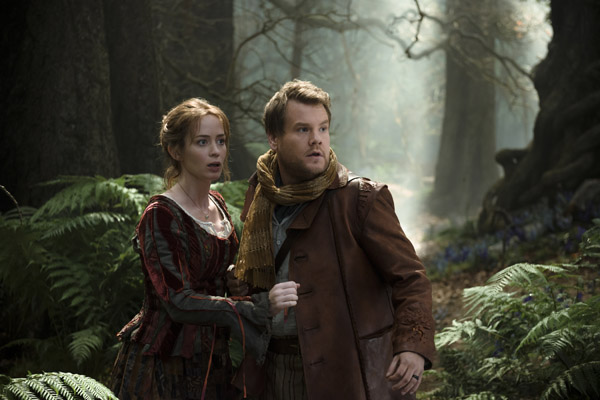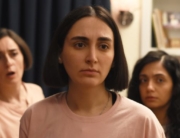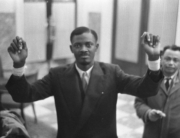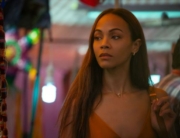Stephen Sondheim’s 1987 Broadway musical is virtually actor proof, as audiences saw in 2002, the last time it appeared on the Great White Way. That’s due to James Lapine’s buoyant and melancholic script and Sondheim’s lyrics, which are noteworthy for their wit and built-in drama. This is certainly one of the most intricate and thoughtful musicals of the 1980s (though it may not have had a lot of competition), and as long as the actors deliver the dialogue and sing the lyrics with clarity, Lapine and Sondheim’s Freudian-laden fantasy world still has the power to move and to overcome any uneven casting.
Written 30 years before the TV soap Once upon a Time, Into the Woods mashes up the fairy tales “Cinderella,” “Rapunzel,” “Little Red Riding Hood,” and “Jack and the Beanstalk,” with all the characters wandering in and out of one another’s story. Woven in is the invented saga of the Baker, whose family line is cursed because his father stole magic beans from the Witch’s garden—the legumes serve as her elixir of youth. To lift the curse plaguing him and his wife, the Baker must find a “cow as white as milk, the cape of red as blood, the hair as yellow as corn, and the golden slipper as pure as gold” within three days.
For the most part, director Rob Marshall has a cast that’s up for the challenge. Vocally, it’s more hit than miss, and a few of the actors not heretofore known for their singing ability, such as Chris Pine playing a royal himbo, shine: Who knew he was such a ham? As the Witch, whose appearances move the plot along, Meryl Streep takes on an imperious part that’s often played with the venom of a bitter drag queen. While Streep holds back in this regard, she belts it out as though under a spell, strangely taking on the vibrato and nasality of the original Witch, Bernadette Peters.
About a half-hour has been trimmed from the original score, without too jarring omissions or abbreviations. At least one number has been completely cut, and many of the songs are shortened. The downside is that there’s less of Sondheim’s deceptively simple wordplay, and the orchestration by Jonathan Tunick, with a faster tempo, lacks the richness of the original arrangement by Paul Gemignani, who conducts and supervises the adapted score.
Lapine’s book already possesses a cinematic sense of storytelling, in which the focus jumps from one story line to the other. The pace swiftly moves from an ol’ English town to Rapunzel’s tower to the dark, dense forest (a sound stage, actually). The film revels in its old-fashioned artifice, and it’s several steps up from, say, the fake frosty set of 1967’s Camelot. That the characters keep bumping into one another on the same path is really the only reminder of the material’s stage origins. Johnny Depp’s sleazy, lascivious Wolf, salivating over the prospect of eating Little Red, is suggested rather than literally presented. Depp remains recognizable underneath the whiskers, pointy ears, and bushy tail; the wardrobe and makeup are more of a throwback to Bert Lahr’s Cowardly Lion than Andy Serkis’s Gollum. (And yes, the words to “Hello, Little Girl” are just as pervy as they were 30 years ago.)
In only one sequence does the film veer toward the look of a VH1 music video. “Agony,” a duet-as-a-competition between two princes-in-heat, features Pine and Billy Magnussen, as Rapunzel’s Prince, huffing and puffing to top each as the most lovelorn. They strut in a stream with a waterfall in the background; viewers might expect Fabio to wander by.
Many of the numbers in Marshall’s first musical film, John Kander and Fred Ebb’s musical Chicago (2002), were edited so rapidly that the choreography was often a blur, and his Nine (2009) was a loose patchwork of musical styles with a lot of razzmatazz disguising its barely cohesive plot. By contrast, the firm story lines of Into the Woods don’t have those problems. Filmed mostly in close-ups or two-shots, it’s methodically and simply told with tongue in cheek, yet Marshall never sends up the material. He takes the plight of Jack’s haranguing mother (Tracy Ullman, in full cranky character actress mode) or the loss of Little Red Riding’s innocence seriously. True to the original, there’s no foreshadowing of a pivotal plot twist, and the narrative ventures in directions that will still surprise audiences.
Many of the cast have a musical theater background: Tammy Blanchard, Christine Baranski, and Anna Kendrick, who won acclaim for the Broadway production of High Society in 1998. Baby boomers should rest assured. As Cinderella, the wan and colorless Kendrick won’t challenge fond memories of Julie Andrews or Leslie Ann Warren in Rodger and Hammerstein’s wide-eyed version of the scullery maid turned princess. Overall, there aren’t as many phoned-in or not-up-to-snuff performances as in Tim Burton’s underpowered Sweeney Todd: The Demon Barber of Fleet Street, where the lead vocals by Depp and Helena Bonham Carter had none of the depth needed for Sondheim’s operatic score.
In the last major mounting of Into the Woods in New York, a 2010 Shakespeare in the Park production, Amy Adams played the Baker’s Wife, and she blended right in with the ensemble, which allowed Donna Murphy’s campy Witch to sashay in the spotlight. That doesn’t happen here. As the Baker’s Wife, Emily Blunt embraces her first great role since her breakout turn as the posh girl in My Summer of Love (2005). Here, she’s the heartbeat of the film, providing it with its most winning and empathetic performance, even though she’s saddled with a stolid James Corden as her milquetoast spouse. She’s the film’s most valuable player.







Leave A Comment